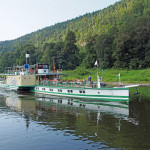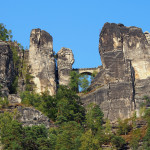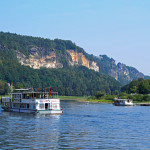From the boat a whole new perspective of the rocks of Saxon Switzerland opens up
Why not take a relaxed look at the rocks from the water? With the many docking stations along the river you can plan your tour individually: From a whole day trip to a short evening ride.

Traditional paddle wheel steamer on its way through the Elbe Valley / Photo: Archive National Park Management, K. Jäpelt

 The annual average temperature in the Elbe Valley is one to two degrees higher than that of the surrounding forested, rocky regions. The warmer and drier climate has its effects on the plants and animals. This corridor is home to specially adapted species that would otherwise not occur in the Elbe Sandstone Mountains. In contrast to the mountain streams, the Elbe Valley has other special habitats t offer. They include diverse ecotones and silt depositions, such as drift lines, riparian trees, willow shrubbery, Elbe puddles and mudpools with residues of alluvial forest. They are closely tied to the changing water levels fo the river.
The annual average temperature in the Elbe Valley is one to two degrees higher than that of the surrounding forested, rocky regions. The warmer and drier climate has its effects on the plants and animals. This corridor is home to specially adapted species that would otherwise not occur in the Elbe Sandstone Mountains. In contrast to the mountain streams, the Elbe Valley has other special habitats t offer. They include diverse ecotones and silt depositions, such as drift lines, riparian trees, willow shrubbery, Elbe puddles and mudpools with residues of alluvial forest. They are closely tied to the changing water levels fo the river.
Remarkable plant species that occur along the Elbe inlcude the catchfly, deergrass, Elbe cocklebur and Vienna squill. Of course, many animal species also inhabit the Elbe River: The Malermuschel mussels and dragonflies like the club-tailed dragonfly and the banded demoiselle. The Elbe is also home to nearly 40 species of fish. One of the most important being the fresh water eel – a fish that has a unique migration pattern. Numerous water birds use the river as a winter home. And, in addition to all of that, the Elbe Valley is also used by some birds as part of their migratory route.
Since the end of the 1970s the Elbe beaver has returned to the river again. It is the only still existing Central European subspecies of the beaver. For a long time these big rodents had disappeared from our landscapes because of the value of their fur and the destruction of their habitats.














